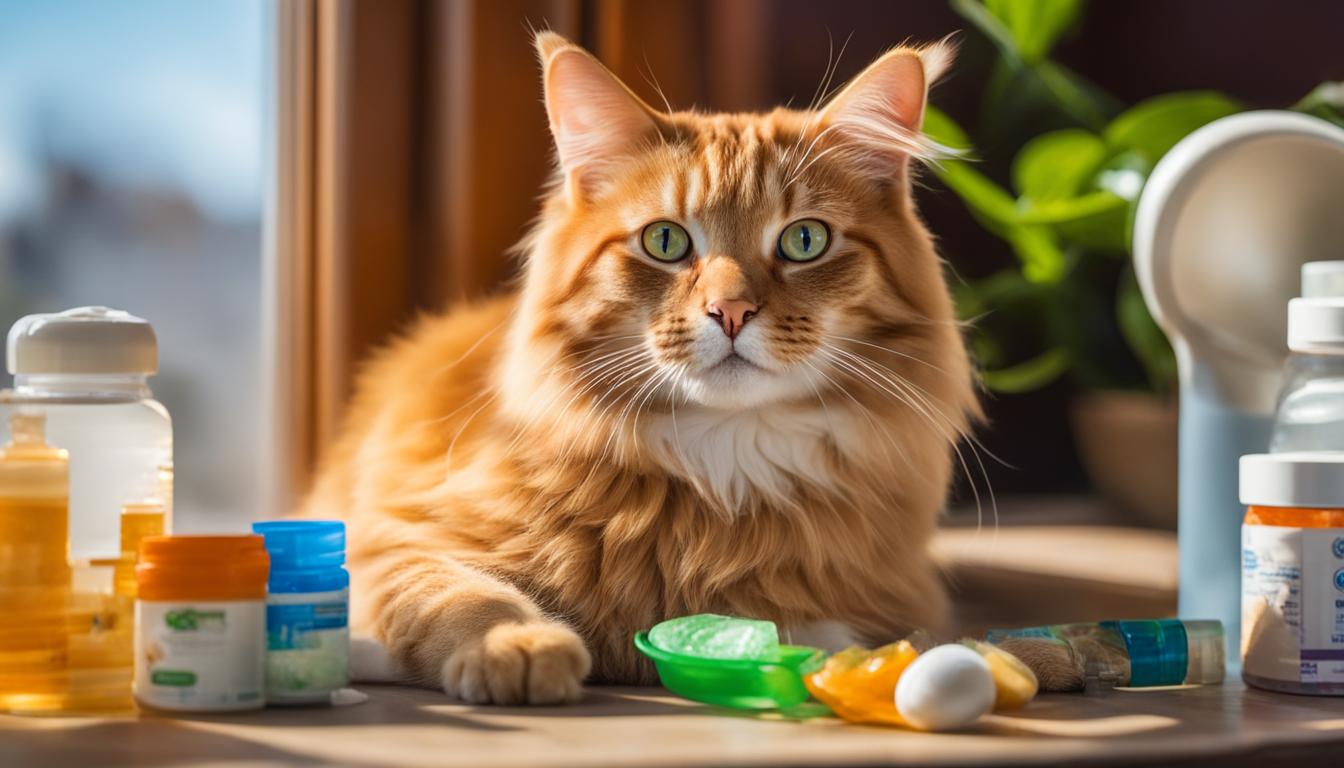If you’re a loving pet owner, you might be curious about your cat’s health and the illnesses they can get. Respiratory syncytial virus (RSV) is something people get, especially little kids. You might wonder if your furry friend can catch it too. While cats can have respiratory problems that seem a lot like a cold, they don’t get RSV the same way people do. They can get other types of bugs that make them sneeze and have runny noses, just like colds in humans. It’s important to take good care of your cats when they are feeling sick and make sure they don’t spread their germs to other cats.
Cats are special and need you to watch out for them. When they’re not feeling well, they might sneeze, have watery eyes, or not want to eat as much. This can happen because of viruses and bacteria that are common in felines. Cats can’t tell us if they feel bad, so we need to keep an eye on them and help them when they are under the weather. Good pet care keeps your cat happy and healthy!
Key Takeaways
- Cats can’t get RSV, but they can catch other infections that affect their breathing.
- Watch for signs like sneezing and runny eyes to spot when your cat may be sick.
- Keeping your cat healthy is a big part of pet care.
- The germs that make cats sick can spread between them, just like colds in people.
- Being a great pet owner means paying attention to your cat’s health and taking action when they are not feeling well.
Exploring Upper Respiratory Infections in Cats
If you have a cat, you might notice sometimes they sneeze or have runny noses, just like people do when they have a cold. These are signs that your kitty might have something called an upper respiratory infection, or URI for short. It’s important to know about URIs, so you can help your cat feel better!
Defining Upper Respiratory Infection (URI)
A URI is a cat’s version of a cold. It can make their noses stuffy and their eyes watery. Imagine how you feel when you have a cold – your nose gets all blocked up, and sometimes you can’t even smell your favorite foods. Cats with a URI feel a bit like that. They need lots of love and care to get better.
Common Symptoms of URI in Felines
You might be wondering how you can tell if your cat has a URI. Here are some signs you can look for:
- Sneezing: ACHOO! Cats sneeze a lot when they have a cold.
- Runny or stuffy nose: Their nose might be wetter than usual or have some goop on it.
- Watery eyes: Your cat’s eyes might look like they’re crying or have some redness.
- Not eating much: They might not want to eat their favorite treats or food.
Remember, if your cat shows any of these signs, it might be time to see the vet.
The Role of Viruses and Bacteria in URI
URIs can be caused by tiny germs that you can’t even see without a microscope. Viruses, like the feline herpes virus and feline calicivirus, are the most common causes. There are also some bacteria, like Mycoplasma and Chlamydophila, that can make cats sick with a URI. These germs can spread from one cat to another. They can be passed on when cats touch noses, share bowls, or even play with the same toys.
Understanding Feline RSV Risks and Symptoms
When you hear about respiratory syncytial virus (RSV) in humans, you might wonder, “Can cats get RSV?” It’s a smart question because our furry friends do get colds, just like us. But even though they sneeze, have runny noses, and feel lazy when they’re sick, they don’t actually get RSV. Instead, cats can catch other kinds of respiratory infections that make them feel under the weather.
As a caring pet owner, it’s important to be aware of the feline RSV risk, which in reality is a risk for similar types of viruses that can affect our cats. Understanding what to look out for will help you take better care of your pets.
- Sneezing
- Runny nose or eye discharge
- Less energy or feeling tired
- Coughing or difficulty breathing
While RSV is something humans need to watch out for, especially in little kids, our cat buddies have their own battles. They might not catch RSV, but they do face a challenge with respiratory infections in pets that are much like the cold viruses we deal with.
When you notice your cat showing these signs, it’s a good idea to check in with the vet. They can help figure out what’s making your cat feel sick and advise you on the best way to make them better. Remember, just like people, when cats get the right care, they can bounce back and feel tip-top again!
Transmission and Spread of Feline URIs
If you’ve ever seen one cat sneeze around another, you might have wondered if they can catch a cold from each other. Just like people, cats can pass certain illnesses back and forth. This can happen in a few ways, like when they sneeze or touch noses. Even their toys or bed can carry germs if a sick kitty has used them.
How Cats Pass Respiratory Infections to Each Other
Imagine if your best friend had a cold and sneezed right next to you. You might get sick next, right? It’s the same for cats! When they sneeze, the tiny wet drops that fly out can carry germs. If another cat breathes in those drops or grooms a sick friend, they might get an upper respiratory infection (URI) too.
The Impact of Stress on Feline Immune Systems
Did you know feeling stressed can make a cat more likely to get sick? When cats move to a new home or feel worried, their bodies might not fight germs as well. That’s because stress can make their immune defenses weaker, so they have a harder time staying healthy. Just like us, cats feel better when they’re calm and safe.
Knowing all this, you can help keep cats healthy by giving them a stress-free home and keeping their things clean. This way, they can play and cuddle without passing germs to each other!
Assessing and Reducing the Risk of URIs in Your Cat
Caring for your cat means understanding what can make them sick. Just like people can catch colds, cats can get upper respiratory infections (URIs). These infections can make your furry friend feel bad. But don’t worry, you can help your cat stay healthy.
Factors That Increase the Risk of URIs
Some cats have a higher chance of getting sick from URIs. Young kittens and older cats don’t have as strong defenses against these germs. Cats who already have health problems, like feline leukemia, may also be at risk. Certain cat breeds with small noses find it harder to breathe when they have a URI.
It’s important to know what makes your cat more likely to get a URI so you can keep an eye out for sneezes and sniffles.
Preventive Measures: Vaccinations and Cat Hygiene
One of the best ways to protect your cat is with feline vaccinations. There is a special shot called the FVRCP vaccine that can help. For cats that spend time outside or live with many other cats, getting a shot for feline leukemia is a good idea too.
Keeping your cat clean and away from sick cats is another way to stop URIs. Let’s look at some easy cat hygiene practices you can try at home:
- Wash your cat’s food and water bowls regularly.
- Keep their bedding nice and clean.
- Give your cat their own space away from other pets.
Remember, using these tips can help your cat feel great and avoid getting a URI. Now, take a look at this table. It shows some simple things you can do to keep your cat healthy:
| Health Tip | Reasons | How It Helps |
|---|---|---|
| Vaccinations | Protects against viruses | Stops the URI before it starts |
| Clean Bowls and Bedding | Keeps germs away | Prevents germs from spreading |
| Separate Sick Cats | Avoids sharing germs | Keeps healthy cats from getting sick |
Staying one step ahead is the key. Give those shots on time, and keep your cat’s sleeping and eating areas tidy. If you follow these tips, you’ll be doing a lot to keep your cat from those sneezy, sniffly URI germs!
Diagnostic Approach for Feline Respiratory Diseases
If your furry friend starts sneezing or has a runny nose, it might be more than just a small cold. Just like humans, cats can get sick too. When our feline pals have these signs, vets do special checks called feline respiratory diagnostics. This means they look closely to find out what’s making our cats feel under the weather. Vets are like cat detectives! They use their eyes and hands during a veterinary examination to see if there is something not quite right.
Sometimes, if the vet thinks it is needed, they might take pictures called x-rays, or even do a blood test. These help them see inside our cat’s body and learn more about what’s going on. If our cats are not getting better with the usual medicines, vets might have to test for specific germs. These tests are called URI diagnostic tests and can tell the vet exactly what kind of medicine will help our cats feel better.
- Inspecting the kitty’s nose and throat
- Listening to the kitty’s breathing
- Checking for fever and other signs
Remember, it’s important to visit the vet if your cat shows signs of being sick. They have all the tools to help our cats get back to chasing toys and purring happily on our laps.
Effective Treatment Plans for Feline Upper Respiratory Infection
When your cat gets a cold, called an upper respiratory infection (URI), you might wonder what’s making them sick. This could be a viral or bacterial infection. Knowing which one your cat has is important to choose the right type of help they need.
Viral vs Bacterial Infections: Understanding the Difference
Most often, cats get viral infections, and here, medicines like antibiotics don’t help. Instead, your cat will need lots of care to feel better. This includes things that help their body fight off the virus like probiotics, which are good bacteria that keep the gut healthy, and other supplements. Keeping your cat well-hydrated with water and making sure they eat are also key to their recovery.
Antibiotics and Supportive Care Options for Cats
If the doctor finds out it’s a bacterial infection, then antibiotics for cats are used. These are special medicines that can kill the bad bacteria making your cat sick. But remember, giving your cat the right love and care is just as important. They might need a cozy, warm spot to rest, gentle grooming, and maybe even a stay at the animal hospital if they’re really unwell. Remember to give your cat lots of pets and attention during this time, so they know you’re there for them while they get better.
FAQ
Can cats contract respiratory syncytial virus (RSV) like humans do?
While cats can experience upper respiratory infections (URIs) similar to colds in humans, they specifically don’t get RSV. Instead, they are susceptible to similar symptoms from other pathogens like the feline herpes virus and feline calicivirus.
What is an upper respiratory infection (URI) in cats?
An upper respiratory infection in cats is a condition that affects their nose, throat, and sinus areas, caused by various viruses and bacteria. Common symptoms include sneezing, nasal congestion, and discharge from the eyes and nose.
What are the signs of a URI in felines?
A cat with a URI may exhibit signs such as persistent sneezing, nasal congestion, discharge from the eyes or nose, eye swelling or redness, and a decrease in appetite.
How do cats pass respiratory infections to each other?
Cats can transmit respiratory infections through direct contact such as grooming, aerosolized particles from sneezing, and indirectly through shared items like food dishes and bedding contaminated with the infectious agents.
Does stress affect a cat’s susceptibility to URIs?
Yes, stress is a significant factor that can suppress a cat’s immune system, making them more vulnerable to URIs. Situations that induce stress, such as changes in environment, can trigger URI symptoms in cats.
What can increase my cat’s risk of getting a URI?
Factors that increase the risk include being a kitten or a senior cat, having pre-existing conditions like feline leukemia or immunodeficiency viruses, and certain breeds with shortened nasal passages.
Are there preventive measures I can take to protect my cat from URIs?
Yes, preventive measures include reducing stress, practicing good hygiene, keeping your cat’s living area clean, and staying up to date with vaccinations, particularly the FVRCP vaccine. For outdoor or shelter cats, vaccination against feline leukemia is also beneficial.
How are feline upper respiratory infections diagnosed?
Veterinarians diagnose URIs through physical examinations and may use tests such as x-rays, blood work, and specific testing for diseases like feline leukemia and immunodeficiency viruses. Additional diagnostic tests may be employed if necessary.
What treatments are available for cats with upper respiratory infections?
Treatment depends on whether the infection is viral or bacterial. Supportive care is typical for viral infections, and antibiotics are used for bacterial aspects. Hydration, nutritional support, and sometimes hospitalization are crucial for recovery, and chronic or secondary infections may require a combination of therapies.
How do vets determine if a cat’s URI is viral or bacterial?
Veterinarians look at the symptoms, and when necessary, they conduct cultures, sensitivity tests, or PCR testing to identify specific pathogens. This helps determine whether the infection is viral or bacterial and guides the appropriate treatment protocol.
Can feline upper respiratory infections be prevented?
While not all URIs can be completely prevented, the risk can be minimized through vaccinations, maintaining good hygiene, keeping stress levels low, and isolating infected cats from healthy ones to prevent the spread of infection.


